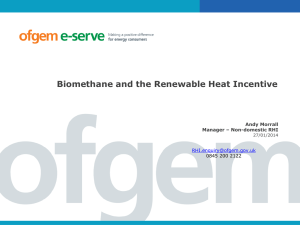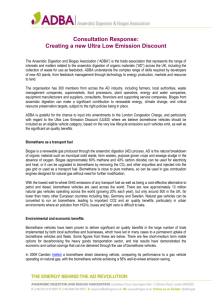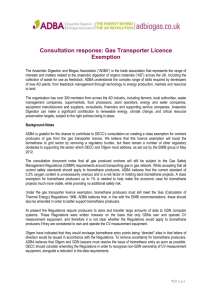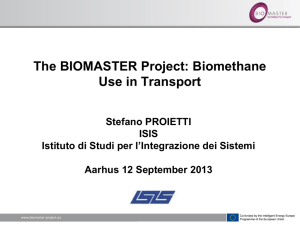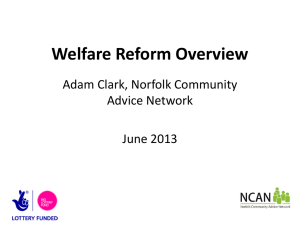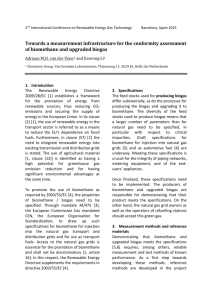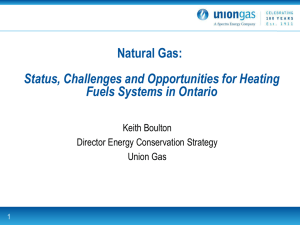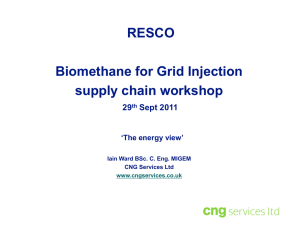HERE. - Norfolk Association of Local Councils
advertisement
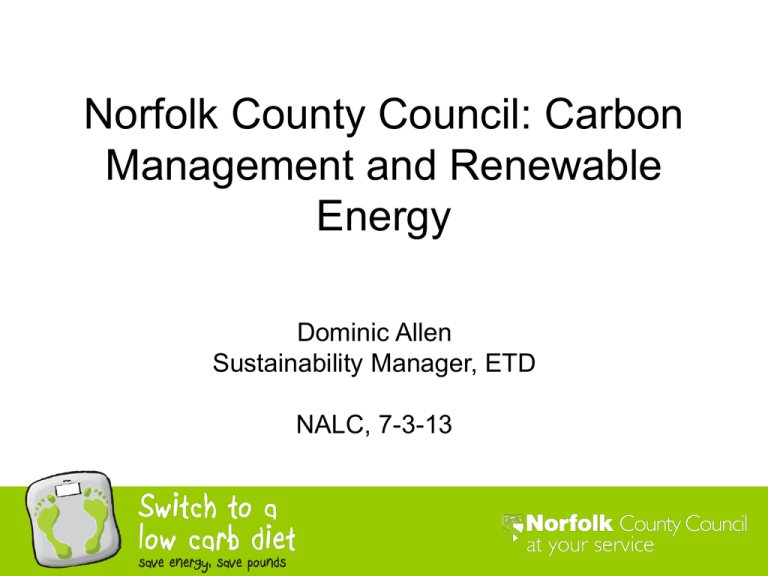
Norfolk County Council: Carbon Management and Renewable Energy Dominic Allen Sustainability Manager, ETD NALC, 7-3-13 Overview • Development of the Carbon Management Programme • European Project - Biomaster • ESCo Drivers • Carbon Reduction – energy efficiency and carbon management programme • Legal obligations – eg Climate Change Act 2008 • Budgetary constraints – rising energy costs • Energy Security – From 1980 – 2003, UK was a net energy exporter In 2008, the UK imported 26% of its natural gas, by 2015, this is likely to be 80% Norfolk County Council’s Carbon & Energy Reduction Programme Target 25% reduction in CO2 emissions and cost savings by 2014,through: Capital investment • to improve energy efficiency of Schools, the NCC estate and fleet, and develop new energy sources Behaviour change by staff and schools • (incl. Energy Busters/ Futures/programme in schools plus corp. ’Low Carb diet’ ) Smarter procurement and management of energy use Legal compliance - satisfying statutory obligations within the national Carbon Reduction Commitment Energy Efficiency Scheme (CRC) Performance to date (2011/12) • We have achieved 17% reduction on the original baseline, equivalent to 16,096 tonnes • Going forward, we have now to reduce our carbon footprint by a further 8% - the equivalent of 7,562 tonnes to reach the target • During 2011/12 we saw a reduction in energy spend of £550,000. This against a backdrop of energy price rises of 9% for gas and 6.5% for electricity • Total energy cost for 2011/12 - £12,225,532 • In total since the start of the programme £3.3m has been saved in energy cost. NCC – carbon emissions NCC total building and streetlighting energy cost What is the CRC? (Carbon Reduction Commitment Energy Efficiency Scheme) • New mandatory emissions trading scheme, targeting @ 5,000 large organisations • Started in April 2010 with three-year introductory phase • Covers all energy sources (electricity, gas, LPG and oil) other than transport fuels • Initially intended to be revenue neutral to the Exchequer, subequent to changes in the CSR 2010, it is now essentially a carbon tax scheme. • It was intended that revenue raised was recycled to participants in the scheme with rewards and penalties based on performance. This no longer the case. There is though a performance league table. Carbon and Energy Reduction Fund - CERF • A fund of £9.8m to improve the energy efficiency of buildings on NCC estate from 2010-2013. (Additional funds earmarked for beyond 2013) • A total of 543 projects have been identified to date, with an allocation of £10.7m and… • …projected cost and carbon savings of £1,618,399 and 6745 tonnes per annum respectively • More recently, investment in smart metering technology • Some limited expansion into renewables on the county estate Case Studies Fire Service • • • • • Green Fleet Review leading to… – Video and web conferencing – Eco-driving course for staff – Car sharing and pool cars – Purchase of lower emission vehicles, including hybrids Retained Fire Officers located nearer to Fire Stations Reduced fuel and mileage costs Retrofit emissions reduction technology on older Fire Trucks Installation of solar PV panels on roofs to generate income from the Feed in Tariff. Case Studies Norfolk Museums and Archaeology Service • Managed to reduce their electricity bill by over 40% (£32K) through utilising new technology. The service has switched from traditional tungsten light fittings to LED* in four of its major museums – Time and Tide, Gressenhall, Norwich Castle and Bridewell The benefits included: - A more even light distribution enabling the use of fewer fittings * LEDs are estimated to run for 50,000 hours compared with 2,000 hours for conventional lamps which means less maintenance is required Solar PV projects installed under the CERF programme – Nov 2011- Feb 2013 • Total projects – 23. A mix of libraries fire stations and schools • Project cost £514,000 • Annual financial benefit - £86,000 (made up of Feed in Tariff, export tariff and energy savings) Communications campaign Improving delivery Success in meeting the reduction target will continue to depend on a number for factors: • • • • • • • • Fast-tracking the disposal of surplus property Optimising energy efficiency is crucial to decisions concerned with all aspects of NCC property maintenance, acquisition or new build Need to involve fully premises managers in real-time monitoring of building performance Continue to drive forward behaviour change Investigate opportunities to reduce the impact of business travel Reduce the impact of owned fleet vehicles. Transport in its fullest sense is still a significant impact Investigate energy impacts linked to water usage. Opportunities to save @ 300 t/CO2/yr. Look to develop a stretch target to 2020. BIOMASTER • Biomethane as an Alternative Source for Transport and Energy Renaissance • European Project May 2011 – May 2014 • Promoting biomethane production and uptake What is Biomethane? • Kitchen Waste • Commercial food waste • Landfill • Sewage • Farm Wastes • Industrial Waste Injection into the gas grid BIOMASTER - Promote production and uptake of biomethane initially within Norfolk Project is split into 3 sections 1. Biogas production and upgrading 2. Biomethane grid injection and other distribution options 3. Biomethane use as a transport fuel NCC is leading on Work Package 3. Work packages • WP3 – Biomethane Production and upgrading • WP4 – Biomethane grid injection • WP5 – Biomethane as a transport fuel Biomethane in transport – gas bus Waste Pretreatment Building Gas Cleanup National Grid Compound Main focus • Viability of any AD plant – Transport/cost issues – Local impacts – Proximity to feed stocks • Feedstock Information Collection and security of supply Energy Services Company (ESCo) – NEF Ltd • • • • • • Approval through Cabinet – Sept ’11 Capital available - £8.3m Company registered – Dec ’11 (Norfolk Energy Futures Ltd) Transition Board in place Business & Investment Plans in development Working through the results of feasibility report for renewables investment on NCC estate • Seeking wider partnership working - with public and private sector, and communities ESCo - NEF Ltd • A private company wholly owned by Norfolk County Council • Aims to provide an income stream to the council as well as supporting the growth in renewable energy uptake within the county, and support the local economy Structure NCC ESCo Project Co. A Project Co. B Project Co. C Project Co. D Maintenance Contract NCC / Community JV Community / Private Sector JV NCC / Private Sector JV Contractor EPC Contractor O&M Current renewables work – CERF/ESCo • 23 projects,including Libraries fire stations and schools • Wind turbines – 19 installed on the County Farms estate. These are 15m, 5kW systems. £470K investment. • Biomass – 4 biomass boiler installed. Fuel sourced locally to reduce transport impacts • Biomass qualifies for the RHI. Therefore expected income from these sites in £77,200/yr More immediately … • Working on a public/private partnership with local green tech company • Exploring community renewable energy projects • Working on a energy package for schools • In discussions to develop partnerships for AD projects Future Projects? • • • • • Anaerobic Digestion Biomass boilers, (better ROI) Wind – small scale Limited opportunities for small scale PV Partnership working to develop community scale projects • Energy crops • Large scale PV. Summing up • Early days • Fits with themes of localism, supporting local economy and green agenda • Desire to remain flexible – right opportunity / technology at the right time Contact details Dominic Allen Sustainability Manager Norfolk County Council dominic.allen@norfolk.gov.uk 01603 224463
